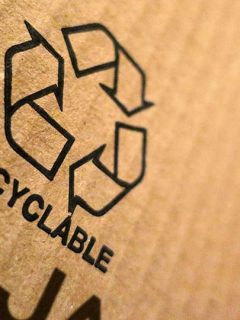Tape is made up of two components: a carrier and an adhesive layer. Nothing more! That carrier can consist of PP, PVC or paper. In this article, we will mainly look at the difference between the first two variants: PP tape and PVC tape. They are both made of plastic and are to this day the most popular adhesive tape variants. Plastic tapes have something for every application! By the way, if you would like to learn more about paper tapes, this blog article will show you the way.
1. How can you tell the difference between PP and PVC tape?
If you only look at the transparency of your tape, you will see that PVC tape is often much duller than the PP variant. Of course, you can only perform this test if you have two tapes in your hands that are transparent.
To be really sure, we recommend doing a simple elasticity test. You then proceed as follows: unroll a piece of tape. Tape one end to your desk, for instance, and hold the other end firmly in your hand. Then take a pen and poke it in the middle of the stretched tape. The following will then happen:
 PVC tape = Due to its great elasticity, the pin will only poke a hole in your tape.
PVC tape = Due to its great elasticity, the pin will only poke a hole in your tape.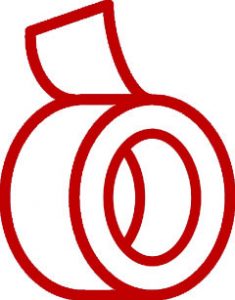 PP tape = this tape is stiffer. If you puncture it with a pin, it will completely snap or tear in.
PP tape = this tape is stiffer. If you puncture it with a pin, it will completely snap or tear in.
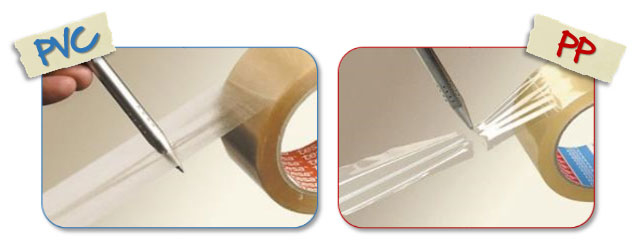
2. All the differences in a nutshell
| PVC tape |
PP tape |
| Low-noise | Not low-noise Exception = low-noise PP tapes |
| Elastic | Rigid |
| Transparency: matt | Transparency: clear |
| Adhesive: solvent | Adhesive: acrylic, solvent or hot melt |
| For medium and heavy packages up to ± 30 à 40 kg |
For lighter parcels up to ± 20 to 30 kg |
3. The properties of PVC tape
PVC used to be the standard in the world of packaging tapes. Although somewhat overshadowed by PP tape today, PVC still remains the most versatile variety on the market. And all thanks to these properties:
- Suitable for medium and heavy packages up to ± 30 to 40 kg.
- Low-noise: when unrolling, it is much quieter than its standard PP counterpart. For people who have to seal boxes all day, for example, this is a lot more pleasant to work with.
- Elastic: As the test above showed, PVC is much more elastic than PP. This makes PVC very versatile. The other side of the coin, however, is that you can never tear off PVC by hand. Scissors or a tape dispenser are indispensable.
- Matt transparency: The tape is not completely transparent. It can sometimes even appear slightly yellowish.
- Adhesive layer: strong natural rubber adhesive (solvent). You can read more about this below (at item 5).
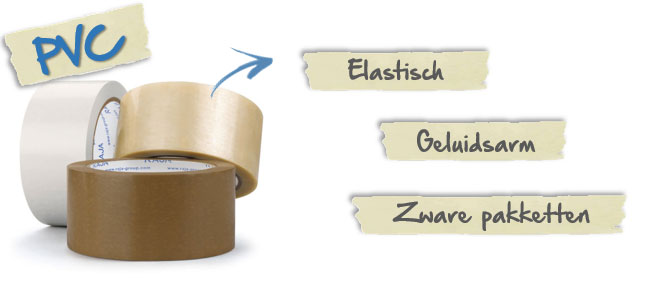
4. The properties of PP tape
PP is an abbreviation for polypropylene, one of the many varieties of plastic. Today, it is the most widely used tape in the packaging world. The fact that it is somewhat cheaper than PVC tape has a lot to do with this. However, the lower purchase price is not the only feature of this tape that stands out:
- Suitable for lighter packages up to ± 20 to 30 kg.
- Non-noise or low noise: PP tape is not quiet in its cheapest standard version. When unrolling, it makes a screeching noise of about 75 decibels. That is as much noise as the passing of a car. Fortunately, there are also low-noise versions. A ‘low noise tape‘ reaches only 60 decibels.
- Rigid: This type of tape is much stiffer in structure and therefore breaks easily when you apply the elasticity test. The advantage of this is that it is easier to tear off by hand.
- Clear transparency: in addition to the familiar brown varieties, there are clear, transparent types. Suppose you have a box printed with your logo, this will remain nicely visible with a transparent PP tape.
- Adhesive layer: fitted with rubber adhesive as standard. In the low-noise variant, acrylic glue is used.
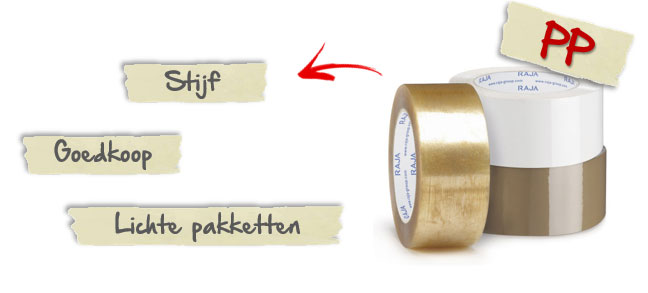
5. What adhesive is used for plastic tapes?
As we mentioned at the introduction, glue is one of the basic components of a tape. There are three variants in it.
-
Acrylic glue: is made on the basis of water. It always remains crystal-clear transparent and therefore does not yellow. This adhesive is often combined with low-noise PP tape.
-
Natural rubber adhesive (solvent): solvent adhesives have a very high adhesive strength and adhere strongly to their backing. They are the most versatile (think outdoor use) and more resistant to low temperatures. You can find them in combination with both PP and PVC.
-
Synthetic rubber adhesive (hot melt): this third form is the cheapest variant. It is used less frequently in export because it is not as resistant to temperature fluctuations. This adhesive sticks best in the short term. This makes it very suitable for e-commerce applications, for example, since parcels there always have to be delivered within a maximum of a few days. It is only used in combination with standard PP tape.
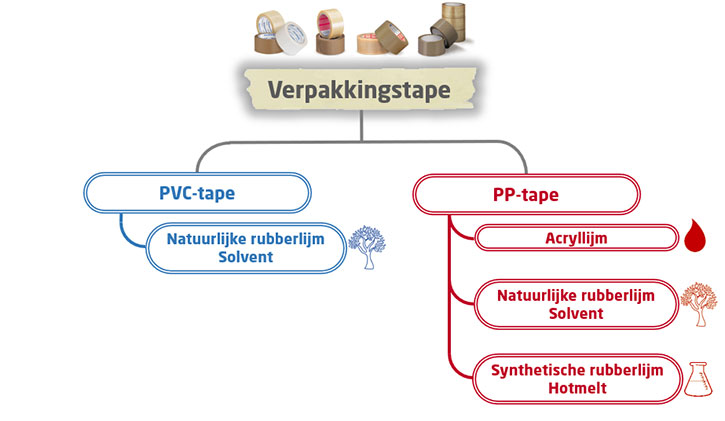
6. How recyclable is plastic tape?
PP and PVC are both made from plastic. That, in turn, has petroleum as its raw material. The good news: this raw material is perfectly recyclable. The ‘not so good’ news: you are forced to always separate the different types of plastic from each other. This produces the best end result after recycling. So sorting is the message!
If your plastic tape sticks to a cardboard box, it is best to make sure it is peeled off the box first. For cardboard recycling, however, there is a tolerance of 3% impurities. Specifically, this means that a bit of plastic on your cardboard box will not harm the recycling process.
]7. Tape: a history that sticks
The tapes we discussed above saw the light of day in the cosmetics sector. Perhaps a bit strange when you consider that today they are mostly used in a lot of ánother sectors.
For the history of tape we have to go back in time to the beginning of the 20th century. We stop at the German company Beiersdorf: a manufacturer of skin care products. You know them from the likes of Nivea and Eucerin. Ointments were their only speciality in the early days.
Out of their search for a solution to permanently protect the skin, the plaster was born. After designing the plaster, it was then only a small step to developing the tape. So you see… thanks to a jar of face cream, you can close your boxes today.















